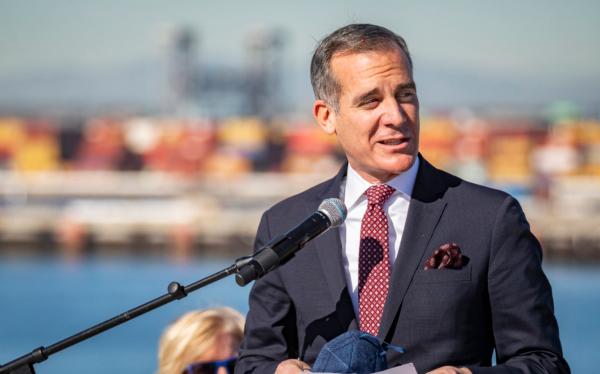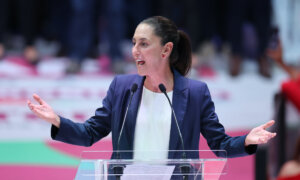Commentary
It’s been more than four years since then-Mayor Eric Garcetti unveiled his ambitious “L.A.’s Green New Deal: Sustainability Plan 2019.” Now, City Controller Kenneth Mejia is calling it a failure, in an analysis released last week. But he was careful to couch the title in the loaded language of climate alarmism: “This Is Not Fine: Hottest Summer on Record Calls for a Reboot of L.A.’s Climate Plan.”
As if Los Angeles, current population 3.8 million and declining from Mr. Garcetti’s policies, could have much influence on the “climate” of a planet with now 8.1 billion people. That is, the city holds just 0.047 percent of the global population.
Moreover, Los Angeles already has some of the world’s strictest anti-air pollution policies, and has spearheaded them since 1947. That means as more people leave the city, it almost insures they will go somewhere with less-strict policies, and therefore pollute more.
But back to Mr. Mejia’s “Reboot” report. It begins: “2023 turned out to be the hottest summer on record—scientists say July was the hottest month in 120,000 years. UN Secretary General António Guterres warned last fall, ‘We are on a highway to climate hell with our foot still on the accelerator.’”
Except on Aug. 14, right in the middle of the supposed long, hot summer, 1,609 climate scientists, including two Nobel science laureates, released a study called “World Climate Declaration: There Is No Climate Emergency.”
It declared: “The geological archive reveals that Earth’s climate has varied as long as the planet has existed, with natural cold and warm phases. The Little Ice Age ended as recently as 1850. Therefore, it is no surprise that we now are experiencing a period of warming. ...

There were 1,609 scientists and informed professionals who signed the Global Climate Intelligence Group's “World Climate Declaration.” (The Epoch Times)
“The world has warmed significantly less than predicted by IPCC [Intergovernmental Panel on Climate Change] on the basis of modeled anthropogenic forcing. The gap between the real world and the modeled world tells us that we are far from understanding climate change.
“There is no statistical evidence that global warming is intensifying hurricanes, floods, droughts and suchlike natural disasters, or making them more frequent. However, there is ample evidence that CO2-mitigation measures are as damaging as they are costly. ...
“To believe the outcome of a climate model is to believe what the model makers have put in. This is precisely the problem of today’s climate discussion to which climate models are central. Climate science has degenerated into a discussion based on beliefs, not on sound self-critical science. Should not we free ourselves from the naive belief in immature climate models?”
Or, as they say in the computer-programming world: GIGO—garbage in, garbage out.
Bad Measuring
Controller Mejia complained: “The 2019 plan consisted of 47 long-term sustainability targets and 97 short-term milestones designed to help the City meet those targets. ...
“In fact, measuring actual progress toward a carbon neutral city is a shortcoming of the 2019 plan. The ‘achieved’ or ‘exceeded’ programs were often low bars. Many lack meaningful targets (‘deploy additional charging stations by2021’—how many is ‘additional’?). Even more were simply focused on writing policies, starting pilots or simply embarking on publicity efforts, e.g., ‘Launch Green New Deal engagement program by 2020.’ Some are too vague to measure. For example, while it is a laudable goal to ‘Create 100,000 green jobs by 2025’ there is no definition of what exactly qualifies as a ‘green’ job.”
Mr. Mejia’s main point: “Given what former Mayor Garcetti described as ‘the existential threat of climate change,’ the small number of outcomes in the Green New Deal fall short of a comprehensive and actionable set of steps to reduce greenhouse gas emissions, the primary driver of climate change.”

An electric vehicle charges on a publicly accessible pole-mounted charger in Los Angeles on Oct. 4, 2022. (Eugene Garcia/AP Photo)
To improve the Green New Deal, he recommended such things as:
- Find ways to leverage L.A.’s assets and power
- Find ways to make reducing carbon emissions easier
- Protect L.A., especially the most vulnerable communities, from the impacts of climate change
- L.A. is a global model, so L.A. must lead
But Mr. Mejia’s recommendations were as vague as those he criticized from Mr. Garcetti’s 2019 proposal.
Garcetti’s Presidential Campaign Platform
Call me cynical, but here’s what the 2019 plan really was about. In February 2019, new Rep. Alexandria Ocasio-Cortez (D-N.Y.) and old Sen. Edward Markey (D-Mass.)
proposed a Green New Deal for the country. It would have enacted draconian controls on the energy economy, plunging America into a massive depression. It was nonbinding and in any case went nowhere. (But it gave a lot of publicity to Ms. Ocasio-Cortez, who
warned at the time, if draconian action were not taken, “The world will end in 12 years.”)
Just a month earlier, in January, Mr. Garcetti canceled his potential presidential run. He needed something to do. So he put forth his own Green New Deal two months after that of Ms. Ocasio-Cortez and Mr. Markey. It was a smart move because it kept him in the news.
When President Joe Biden took office, in July 2021 he picked Mr. Garcetti to be ambassador to India, one of the world’s top diplomatic posts. Then a scandal erupted about sexual harassment in Mr. Garcetti’s office. He weathered that and finally was confirmed by the U.S. Senate in March 2023.
Garcetti in India
Given his disastrous performance in L.A., it was a poor choice. India now is the world’s most populous nation with 1.4 billion people, and the fourth largest economy. Unlike Communist China, with its repressive policies, democratic India’s population is growing instead of shrinking. The World Bank
estimates its economy, using the Purchasing Power Parity measure, is now the third largest at $11.9 trillion; after only China’s $30.3 trillion and America’s $25.5 trillion.
This should have been a job for a top-level professional diplomat who speaks Hindi and knows the culture and politics.
In June, according to the U.S. Embassy in New Delhi, Mr. Garcetti announced, “To safeguard global peace and prosperity, we need a bold agenda to confront global climate change. There is no issue that is more fundamental to the well-being of all our peoples than access to clean air. As Ambassador, I will prioritize working with India to build green energy solutions and will support our growing bilateral effort to ensure a successful green energy transition.”

Mayor Eric Garcetti speaks to journalists in Long Beach, Calif., on Jan 11, 2022. (John Fredricks/The Epoch Times)
But his speech, and his L.A. Green New Deal from his days as mayor, have had no effect on India’s own climate policies. As I reported last January in the Epoch Times, like rival China, India is increasing coal use for energy, not decreasing it.
Here’s an update from Reuters last month: “[T]he driest August in more than a century has resulted in power generation surging to a record 162.7 billion kilowatt hours (units), a Reuters analysis of data from the federal grid operator Grid India showed.
“Coal’s share in power output rose to 66.7% in August—the highest for the month in six years, according to a Reuters analysis of government data. Lower rainfall lead to the share of hydro power in overall output plunging to 14.8%, compared with 18.1% in the same period last year.”
Conclusion: Making Angelenos More Miserable
I traveled with my family from Detroit to Los Angeles on vacation in 1964. I still watch our old family movies and can see the heavy smoke over the City of the Angels. But Detroit was like that then, too.
Since then, these and other cities in America and the most developed nations have reduced smog sharply. That’s sensible. But it’s about all that really can be done. Just make life better for the people who live where you are. Fixing “climate change” is a chimera.
India, China, and other still-developing countries are not going to stifle their economic development to make American environmentalists and presidential candidates feel good.
Mr. Mejia’s critique of the L.A. Green New Deal didn’t go far enough. Instead of recommending improvements, it should have called for canceling the whole absurd project.

















